Quinaldine Ethiodide
Modify Date: 2024-01-02 18:56:33
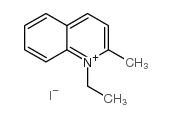
Quinaldine Ethiodide structure
|
Common Name | Quinaldine Ethiodide | ||
|---|---|---|---|---|
| CAS Number | 606-55-3 | Molecular Weight | 299.15100 | |
| Density | 0.972g/cm3 | Boiling Point | 268.4ºC at 760 mmHg | |
| Molecular Formula | C12H14IN | Melting Point | 244 °C (dec.)(lit.) | |
| MSDS | Chinese USA | Flash Point | 106.2ºC | |
| Symbol |

GHS07 |
Signal Word | Warning | |
| Name | 1-ethylquinaldinium iodide |
|---|---|
| Synonym | More Synonyms |
| Density | 0.972g/cm3 |
|---|---|
| Boiling Point | 268.4ºC at 760 mmHg |
| Melting Point | 244 °C (dec.)(lit.) |
| Molecular Formula | C12H14IN |
| Molecular Weight | 299.15100 |
| Flash Point | 106.2ºC |
| Exact Mass | 299.01700 |
| PSA | 3.88000 |
| Index of Refraction | 1.536 |
Synonym:N-ethylquinaldinium; 1-ethyl-2-methylquinolinium iodide; 2-methylquinoline ethiodide; Quinaldine ethiodide; Quinolinium, 1-ethyl-2methyl, iodide (9CI Section 2 - COMPOSITION, INFORMATION ON INGREDIENTS
Risk Phrases: 36/37/38 Section 3 - HAZARDS IDENTIFICATION EMERGENCY OVERVIEW
Irritating to eyes, respiratory system and skin.Moisture sensitive.The toxicological properties of this material have not been fully investigated. Potential Health Effects Eye: Causes eye irritation. Skin: Causes skin irritation. Ingestion: May cause irritation of the digestive tract. Inhalation: Causes respiratory tract irritation. Chronic: No information found. Section 4 - FIRST AID MEASURES Eyes: Immediately flush eyes with plenty of water for at least 15 minutes, occasionally lifting the upper and lower eyelids. Get medical aid immediately. Skin: Get medical aid. Immediately flush skin with plenty of water for at least 15 minutes while removing contaminated clothing and shoes. Ingestion: Do not induce vomiting. If victim is conscious and alert, give 2-4 cupfuls of milk or water. Never give anything by mouth to an unconscious person. Get medical aid immediately. Inhalation: Remove from exposure and move to fresh air immediately. If not breathing, give artificial respiration. If breathing is difficult, give oxygen. Get medical aid. Notes to Physician: Section 5 - FIRE FIGHTING MEASURES General Information: As in any fire, wear a self-contained breathing apparatus in pressure-demand, MSHA/NIOSH (approved or equivalent), and full protective gear. During a fire, irritating and highly toxic gases may be generated by thermal decomposition or combustion. Extinguishing Media: Use water spray, dry chemical, carbon dioxide, or appropriate foam. Section 6 - ACCIDENTAL RELEASE MEASURES General Information: Use proper personal protective equipment as indicated in Section 8. Spills/Leaks: Clean up spills immediately, observing precautions in the Protective Equipment section. Sweep up, then place into a suitable container for disposal. Avoid generating dusty conditions. Section 7 - HANDLING and STORAGE Handling: Wash thoroughly after handling. Use with adequate ventilation. Avoid contact with skin and eyes. Avoid ingestion and inhalation. Storage: Store in a cool, dry place. Keep container closed when not in use. Section 8 - EXPOSURE CONTROLS, PERSONAL PROTECTION Engineering Controls: Use adequate ventilation to keep airborne concentrations low. Exposure Limits CAS# 606-55-3: Personal Protective Equipment Eyes: Wear appropriate protective eyeglasses or chemical safety goggles as described by OSHA's eye and face protection regulations in 29 CFR 1910.133 or European Standard EN166. Skin: Wear appropriate protective gloves to prevent skin exposure. Clothing: Wear appropriate protective clothing to prevent skin exposure. Respirators: Follow the OSHA respirator regulations found in 29 CFR 1910.134 or European Standard EN 149. Use a NIOSH/MSHA or European Standard EN 149 approved respirator if exposure limits are exceeded or if irritation or other symptoms are experienced. Section 9 - PHYSICAL AND CHEMICAL PROPERTIES Physical State: Powder Color: yellow Odor: Not available. pH: Not available. Vapor Pressure: Not available. Viscosity: Not available. Boiling Point: Not available. Freezing/Melting Point: 244 deg C (dec) Autoignition Temperature: Not available. Flash Point: Not available. Explosion Limits, lower: Not available. Explosion Limits, upper: Not available. Decomposition Temperature: Solubility in water: Specific Gravity/Density: Molecular Formula: C12H14IN Molecular Weight: 299.14 Section 10 - STABILITY AND REACTIVITY Chemical Stability: Stable under normal temperatures and pressures. Conditions to Avoid: Incompatible materials, moisture. Incompatibilities with Other Materials: Strong oxidizing agents. Hazardous Decomposition Products: Nitrogen oxides, carbon monoxide, irritating and toxic fumes and gases, carbon dioxide, hydrogen iodide, iodide ions (I-). Hazardous Polymerization: Has not been reported Section 11 - TOXICOLOGICAL INFORMATION RTECS#: CAS# 606-55-3: VA0740000 LD50/LC50: Not available. Carcinogenicity: Quinolinium, 1-ethyl-2-methyl-, iodide - Not listed by ACGIH, IARC, or NTP. Other: See actual entry in RTECS for complete information. Section 12 - ECOLOGICAL INFORMATION Section 13 - DISPOSAL CONSIDERATIONS Dispose of in a manner consistent with federal, state, and local regulations. Section 14 - TRANSPORT INFORMATION IATA Not regulated as a hazardous material. IMO Not regulated as a hazardous material. RID/ADR Not regulated as a hazardous material. Section 15 - REGULATORY INFORMATION European/International Regulations European Labeling in Accordance with EC Directives Hazard Symbols: XI Risk Phrases: R 36/37/38 Irritating to eyes, respiratory system and skin. Safety Phrases: S 24/25 Avoid contact with skin and eyes. S 26 In case of contact with eyes, rinse immediately with plenty of water and seek medical advice. S 36/37/39 Wear suitable protective clothing, gloves and eye/face protection. WGK (Water Danger/Protection) CAS# 606-55-3: No information available. Canada CAS# 606-55-3 is listed on Canada's DSL List. CAS# 606-55-3 is not listed on Canada's Ingredient Disclosure List. US FEDERAL TSCA CAS# 606-55-3 is listed on the TSCA inventory. SECTION 16 - ADDITIONAL INFORMATION N/A |
CHEMICAL IDENTIFICATION
HEALTH HAZARD DATAACUTE TOXICITY DATA
|
| Symbol |

GHS07 |
|---|---|
| Signal Word | Warning |
| Hazard Statements | H315-H319-H335 |
| Precautionary Statements | P261-P305 + P351 + P338 |
| Personal Protective Equipment | dust mask type N95 (US);Eyeshields;Gloves |
| Hazard Codes | Xi |
| Risk Phrases | R36/37/38 |
| Safety Phrases | S26-S37/39 |
| RIDADR | NONH for all modes of transport |
| WGK Germany | 3 |
| RTECS | VA0740000 |
| Precursor 3 | |
|---|---|
| DownStream 10 | |
| MFCD00031829 |
| EINECS 210-120-7 |
| 1-ethyl-2-methylquinolin-1-ium,iodide |
| Quinaldine Ethiodide |
| 1-Ethyl-2-methylquinolinium iodide |
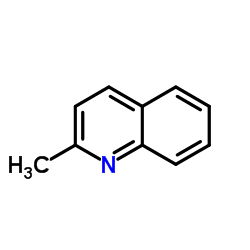 CAS#:91-63-4
CAS#:91-63-4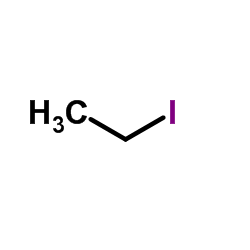 CAS#:75-03-6
CAS#:75-03-6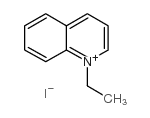 CAS#:634-35-5
CAS#:634-35-5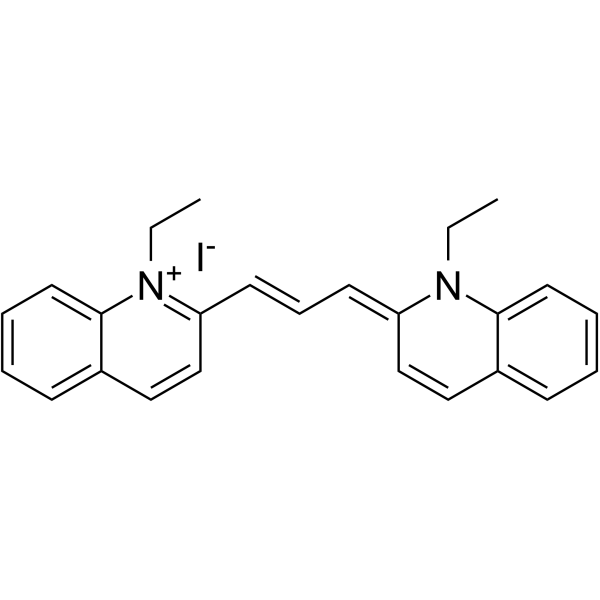 CAS#:605-91-4
CAS#:605-91-4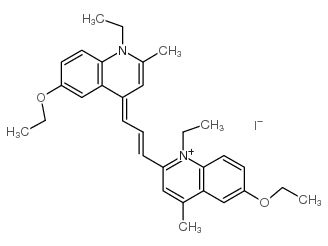 CAS#:20591-23-5
CAS#:20591-23-5![Quinolinium,1-ethyl-2-[[3-[(1-ethyl-2(1H)-quinolinylidene)methyl]-2-hydroxy-4-oxo-2-cyclobuten-1-ylidene]methyl]-,inner salt structure](https://www.chemsrc.com/caspic/219/23475-74-3.png) CAS#:23475-74-3
CAS#:23475-74-3 CAS#:977-96-8
CAS#:977-96-8![Quinolinium,1-ethyl-2-[(1-ethyl-4(1H)-quinolinylidene)methyl]-, iodide (1:1) structure](https://www.chemsrc.com/caspic/441/634-21-9.png) CAS#:634-21-9
CAS#:634-21-9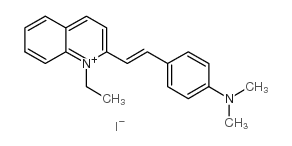 CAS#:117-92-0
CAS#:117-92-0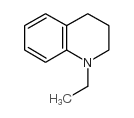 CAS#:16768-69-7
CAS#:16768-69-7![1-ethyl-2-[3-(3-ethyl-3H-benzothiazol-2-ylidene)prop-1-enyl]quinolinium iodide structure](https://www.chemsrc.com/caspic/123/18248-94-7.png) CAS#:18248-94-7
CAS#:18248-94-7![N-[2-(1-ethylquinolin-1-ium-2-yl)ethenyl]-N-methylaniline,iodide structure](https://www.chemsrc.com/caspic/069/76529-17-4.png) CAS#:76529-17-4
CAS#:76529-17-4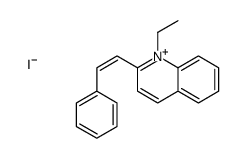 CAS#:50387-21-8
CAS#:50387-21-8
